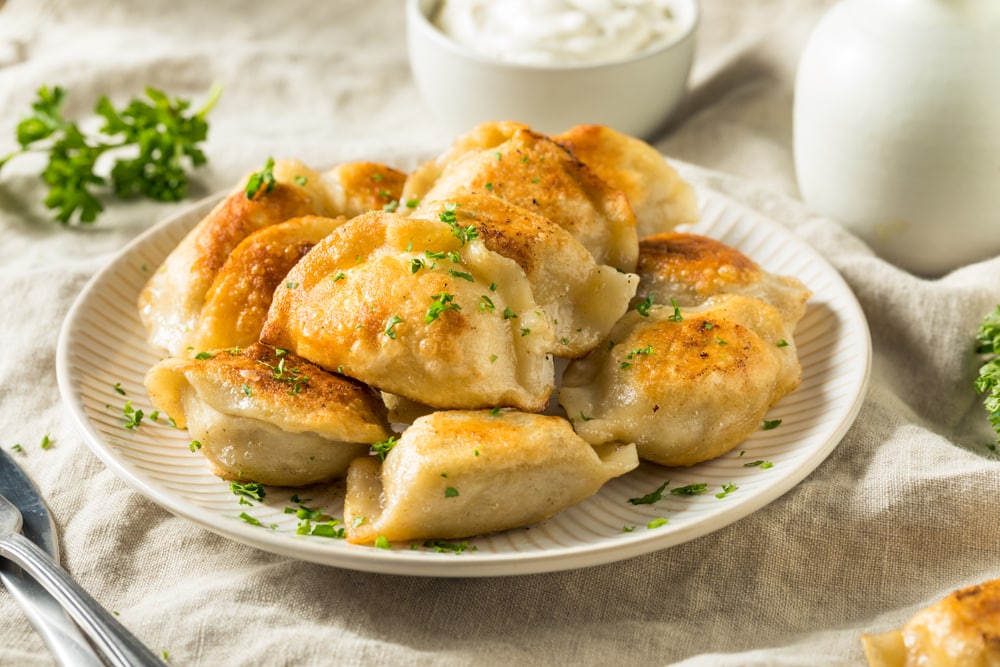
Dumplings have become the ultimate Chinese food and people love to eat them with chili sauce and other sauces. Since it’s a Chinese food option, people often consider that it’s the only variant. However, pelmeni vs. pierogi is a common comparison as these are different variants of dumplings. In this article, we are sharing the differences!
Pelmeni vs Pierogi
Pelmeni
Pelmini is a dumpling dish and is famous in Russian cuisine. It is made by filling different ingredients in unleavened and thin dough. When it comes down to the origin, there has always been a debate between Siberia and Ural but nobody knows for sure. These dumplings are made by using dough that’s made with a combination of water, flour, and a small egg portion. With pelmeni, the filling is made with minced meat and mushrooms.
When it comes down to the mince, it can be made from fish, beef, lamb, and pork, so it depends on where you are eating them from. In the majority of cases, people make a mixture of different meats to make mince for filling the dumplings. As for the spices, it uses black pepper, garlic, and diced onions. These Russian dumplings are served with the topping of vinegar, sour cream, dill, mayonnaise, and red onions. In some regions, people add horseradish, tomatoes, and cabbage in mince.
With pelmeni, the stability and consistency of the dough will depend on the humidity and temperature of the region. When we talk about the origin, the majority of people believe that the Ural is the real origin of pelmeni. What’s most interesting is that pelmeni is used for preserving meat during the never-ending winter season of Siberia and the overall cooking method of dumplings is pretty much influenced by Siberia. The term pelmeni is widely used to describe different eastern European dumplings, irrespective of filling and size.
It is extremely similar to bansh, which is a Mongolian dish. However, the primary difference lies in the dough shell’s thickness because pelmeni has the thinnest dough. In addition, it uses more filling as compared to other varieties. It cannot be served with sweet sauces or sides. On top of everything, pelmeni tends to be cooked with raw meat. Overall, these dumplings have a size of two centimeters to three centimeters. Last but not least, it can be served with light broth to enhance the flavor.
Pierogi
Pierogi is the filled dumplings and are common to Eastern European and Central European cuisines. This is generally more famous in Canada and America but goes by different local names. These are filled dumplings that use the unleavened dough for making them up. In addition, they can be made with sweet as well as savory filling (it depends on the menu) and are cooked in boiling water. After boiling, they are pan-fried before they are served to the customers.
When it comes down to the filling of pierogi, it is made by combining potatoes, mushrooms, ground meat, quark, and sauerkraut. If you order a savory variant, it will be served with fried onions, sour cream, and broth. Some people also call it pie in the Slavic regions, so beware different terminologies are used. In Ukraine, pierogi is known as varenyky. If you are concerned about the origin of pierogi, it is highly likely that they originated in Eastern Europe or Central Europe but it’s still not verified.
If you are thinking about how it’s made, it is stuffed with different ingredients, such as cheese, mushrooms, meat, cabbage, mashed potatoes, spinach, farmer cheese, quark, fried onions, and sauerkraut. These are different ingredients and chefs just pick any of the said ingredients. Dumplings are also available in a sweet version, and those are stuffed with fruit filling, including raspberry, cherry, plum, apple, blueberry, and strawberry.
On the other hand, savory variants are served with sour cream and some people also add it to the dough to lightening up its texture. As far as the dough is concerned, it is made by combining warm water and flour but some people add eggs to make the dough soft. When the dough is ready, it’s rolled and cut down into circles and square,s and filled up with the desired filling. Also, some regional variants use salt and curd in the dough as well.